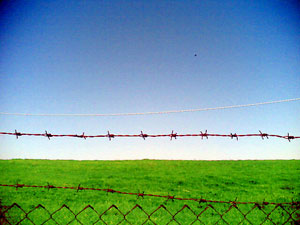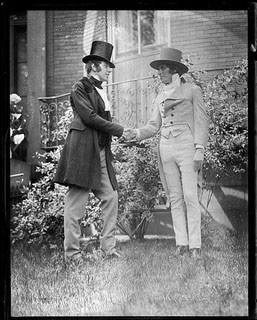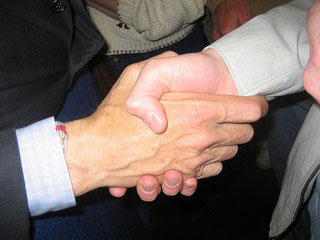
Source: .. domani vado a votare con le cesoie! ..., hidden side, Flickr
Let’s study another poem that uses metaphor, as well as personification, sensory imagery (imagery that appeals to the five senses), alliteration (two or more adjacent words that begin with the same sound), and onomatopoeia (words that sound like what they mean).
A metaphor is a type of figurative language that goes beyond the literal to suggest a deeper meaning. Objects that are personified (i.e., that take on human characteristics) also hint at a larger meaning. When you recognize and interpret a metaphor or personification in poetry, you are cracking open the egg to uncover more meaning.
Robert Frost was a famous American poet who lived in rural New England in the early twentieth century. He used this setting to express deeper meanings about life.
In the excerpt from the poem “Mending Wall,” you will find several images that describe a rock wall. The wall divides two properties: one of apple trees and one of pine trees. Refer to the mouse-over definitions in the first paragraph of this section and see if you can find metaphors and the use of personification in Frost’s poem.

Read the entire excerpt first, and then read it again and click on the metaphors. If you choose correctly, they will highlight in green. Next, click on the examples of personification. If you choose correctly, the examples will highlight in pink. (Hint: You should find four metaphors and two uses of personification.)
Mending Wall
By Robert Frost
I let my neighbour know beyond the hill;
And on a day we meet to walk the line
And set the wall between us once again.
We keep the wall between us as we go.
To each the boulders that have fallen to each.
And some are loaves and some so nearly balls
We have to use a spell to make them balance:
“Stay where you are until our backs are turned!”
We wear our fingers rough with handling them.
Oh, just another kind of out-door game,
One on a side. It comes to little more:
There where it is we do not need the wall:
He is all pine and I am apple orchard.
My apple trees will never get across
And eat the cones under his pines, I tell him.
He only says, “Good fences make good neighbours.”
Source: Rock wall, Dey, Flickr
Now, use what you know about metaphors and personification and closely read the poem again. As you read, ask yourself the question “Do good fences make good neighbors?” To answer this question, look for evidence found in the poem’s figurative devices and language. This evidence will help you uncover meaning. Once you begin to uncover meaning, you can make inferences and respond to the question.

Source: Old Boston, Boston Public Library, Flickr
Let’s think about the evidence. You know from the beginning that two neighbors are meeting to mend the wall that separates their property. Think about how the speaker in the poem describes the wall. The metaphor “some are loaves” suggests that the boulders look like rectangular loaves of bread, so you might picture a stack of bread loaves.
The metaphor “some so nearly balls” suggests that some boulders in the wall are round rather than loaf-shaped. You might infer from this evidence that the speaker in the poem is describing a wall that contains a mixture of rectangular and round rocks.
Next, the speaker in the poem comments that the wall is not particularly sturdy. He says, “We have to use a spell to make them balance.” You might infer that the speaker is suggesting that fixing the wall is not an easy task and that he and his neighbor just have to hope the wall stays repaired once it is fixed. From his use of personification, you might also make the inference that the speaker is not so sure that mending the wall is really necessary. Consider this information as you do the next exercise.
 Make some inferences about the poem based on evidence, including metaphors and the use of personification. Think about the question “Do good fences make good neighbors?” Then copy and paste the chart below into your notes. Write the evidence you find into the chart. Make your inferences from the evidence and write these into the chart as well. An example is shown on the first row of the chart. When you’re finished, check your understanding to view possible responses.
Make some inferences about the poem based on evidence, including metaphors and the use of personification. Think about the question “Do good fences make good neighbors?” Then copy and paste the chart below into your notes. Write the evidence you find into the chart. Make your inferences from the evidence and write these into the chart as well. An example is shown on the first row of the chart. When you’re finished, check your understanding to view possible responses. | Evidence | Inference |
|---|---|
|
“We wear our fingers rough with handling them.” |
Repairing the wall is a great deal of work. Reading this makes me wonder if all that work is worth it. |
|
|
|
|
|
|
|
|
|
|
|
|
| Evidence | Inference |
|---|---|
|
“We wear our fingers rough with handling them.” |
Repairing the wall is a great deal of work. Reading this makes me wonder if all that work is worth it. |
|
“Oh, just another kind of out-door game, |
The speaker is suggesting that repairing the wall is like a game. I’m really beginning to think that the speaker thinks the work is a waste of time. |
|
“There where it is we do not need the wall:” |
The speaker has admitted that a wall isn’t needed. |
|
“He is all pine and I am apple orchard.” |
These metaphors are saying that the neighbor’s property contains only pine trees, while the speaker’s is an apple orchard. I think the speaker is suggesting that because the properties have different trees, they will be easy to tell apart. Maybe a wall isn’t needed. |
|
“My apple trees will never get across |
The speaker personifies the trees by saying that his apple trees will never cross over to eat the pine cones under his neighbor’s pine trees. I think the speaker is definitely saying a wall is not needed. |

Source: President Clinton Shakes my Hand, M Schu Reads
Now, think about the question “Do good fences make good neighbors?” Frost’s speaker seems to be saying that the work of building walls between neighbors may be unnecessary. The boulders tend to fall, and the two types of trees the wall divides don’t pose a threat to each other.
Can you go even further with your inferences? Maybe the speaker is saying that we need to remove the metaphorical or imaginary walls that divide us from other people. In the poem, the neighbor disagrees with the speaker. He says, “Good fences make good neighbors.”
What can you infer from this final statement? Maybe neighbors coming together to rebuild a wall helps them talk to one another. “Mending” a wall may lead to “mending” a relationship. That is a complex inference, and it is only one possible interpretation. Another possible inference is that the mending wall line can be understood as much less optimistic: staying separated keeps the relationship from becoming troublesome. While this may not be Frost’s point, it may be the neighbor’s point.
Remember, your first step in getting here is finding examples of poetic devices. After you find them, you need to think about what they add to your understanding of the poem. Next, you use these ideas to build evidence for your inferences.
To return to the egg example from previous sections, identifying poetic devices without figuring out what they mean is like cracking open a raw egg without any purpose in mind. You need to figure out what the devices mean to make inferences, just as you need to have a reason for cracking open an egg.